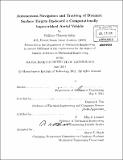Autonomous navigation and tracking of dynamic surface targets on-board a computationally impoverished aerial vehicle
Author(s)
Selby, William Clayton
DownloadFull printable version (14.46Mb)
Other Contributors
Massachusetts Institute of Technology. Dept. of Mechanical Engineering.
Advisor
Daniela L. Rus.
Terms of use
Metadata
Show full item recordAbstract
This thesis describes the development of an independent, on-board visual servoing system which allows a computationally impoverished aerial vehicle to autonomously identify and track a dynamic surface target. Image segmentation and target tracking algorithms are developed for the specific task of monitoring whales at sea. The computer vision algorithms' estimates prove to be accurate enough for quadrotor stabilization while being computationally fast enough to be processed on-board the platform. This differs from current techniques which require off-board processing of images for vehicle localization and control. The vision algorithm is evaluated on video footage to validate its performance and robustness. The quadrotor is then modeled to motivate and guide the development of Linear Quadratic Regulator (LQR) controllers for maneuvering the quadrotor. The controllers are tuned using a motion capture system which provides ground truth state measurements. The vision system is integrated into the control scheme to allow the quadrotor to track an iCreate. Additionally, an Extended Kalman Filter (EKF) fuses the vision system position estimates with attitude and acceleration measurements from an on-board Inertial Measurement Unit (IMU) to allow the quadrotor to track a moving target without external localization.
Description
Thesis (S.M.)--Massachusetts Institute of Technology, Dept. of Mechanical Engineering, 2011. Cataloged from PDF version of thesis. Includes bibliographical references (p. 113-120).
Date issued
2011Department
Massachusetts Institute of Technology. Department of Mechanical EngineeringPublisher
Massachusetts Institute of Technology
Keywords
Mechanical Engineering.